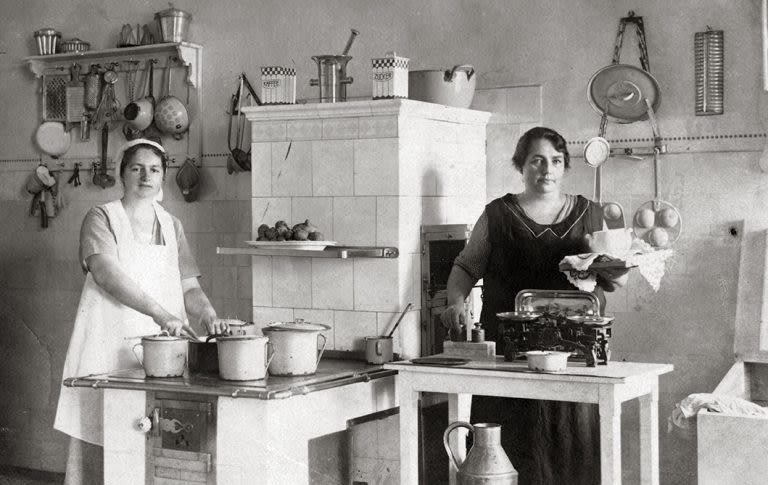
The apron's history spans across centuries to its modern usage in the home and various industries today. The practical use and function of the apron has always been to protect clothing from getting dirty or damaged. Although, at times it evolved into a fashion statement or indication of status, overall it has been recognized as a form of protective garment. If we go far enough back, the loin cloth could even be considered a type of apron.
Origin & Evolution of the Apron
In the 14th century a small tablecloth, known as a “naperon” in medieval French, was used to place over the larger tablecloth to protect it from spills. Around the 17th century, the word “apron” had evolved into what we know today and was an article being worn as a layer atop clothing to protect it.
As the evolution of the item continued, it was common to be embellished and adorned with jewels and worn to depict status. Other aprons were worn for sacred and ritualistic purposes.
The earliest recorded appearance of these “aprons” dates back to paintings from the 1300s. Aprons remained a functional item through the medieval times but evolved, for a time, into fashion worn by women who lived in the type of luxury that would afford the wearing of a decorative apron. These were not the same simple aprons worn in the medieval times by workers. It is common to see art depicting the medieval and renaissance time period with women wearing aprons.
In the time before washers and dryers, wearing an apron meant the clothing beneath was protected. The apron could more easily be washed leaving the clothing to be worn longer between washes. Early Americans owned very few garments,especially those settling the earliest colones. Pilgrims are often depicted wearing aprons because of the need to keep whatever the did own clean and protected for as long as possible.
The 1920s and 40s brought about the flour sack or feed sack aprons. Due to the Great Depression, aprons were made from repurposing old flour sacks. Manufacturers recognized that customers were reusing their packaging and seized the opportunity to offer different prints like florals, bordered designs and even doll and toy patterns.
Around the 1950s America was introduced to the iconic american housewife, a domestic genius. This time period conjures up images of baked goods and family dinners and are always depicted with the wife wearing her ever present apron.
Through the remainder of the century the popularity of aprons ebbed and flowed. The following decade was met with women stepping away from the role of an ordinary housewife and the apron was suddenly deemed old-fashioned. Whether the apron was popular in the household or not, throughout the years the apron has always remained a necessity in the workplace.
Industries & Aprons Styles
Before jumping into the industries that benefit from the use of aprons, let’s go over the different designs and styles first.
Apron Styles
Bib: A bib apron is the most commonly seen household type of aprol. Also referred to as a full apron, it covers nearly the full length of the body ending mid-thigh or at the knees. It ties at the waist with a loop around the neck or ties that fasten at the nape of the neck.
Half Apron: This traditional kitchen apron, known also as a waist apron, tied around the waist and ended around mid-thigh. It gained popularity in the 1950s
Cross back: A full apron where the back straps cross over the shoulders and across the back instead of tying behind the neck.
Industries
Color and style both come into play when it comes to selecting an apron that fits a certain industry.
A traditional white apron is generally worn by head chefs, even more so than a chef’s hat. It is highly visible and signifies cleanliness. These chef whites ensure the wearer protected from stains, burns and spills.
Many industries have styles and colors that have been worn historically. Butchers traditionally wore blue pinstriped bib aprons. Today they wear the same. Many industries wore certain designs and colors to distinguish their trade. The same look has continued today. Another example would be a painted wearing white.
Half aprons are popular among the hospitality industry. A waiter wearing a half apron, utilizes a style with extra pockets to have access to store things like silverware, straws and the meal ticket when hands are full with other items.
There are numerous industries that benefit from the use of aprons as part of their company apparel.
Modern Apron Usage
Today household aprons serve their primary purpose of protecting clothing from common kitchen mishaps and spills, but popularity has grown as they have started adding some fun in the style, design and even the addition of a clever or funny saying decorating the front.
In terms of today’s industrial wear, aprons are used to keep clothing clean but have a myriad of other benefits that go along with that. Benefits can include:
Hygienic aprons
Set a professional tone
Add to the overall look of a company
Resist burns
Resist stains
Heat resistant
Whether the apron is for a waiter or the head chef, they can be designed with additional benefits and levels of protection to match the work environment they are worn in.
No matter the industry, Alsco’s aprons will keep you looking sharp.
Sources
https://fashion-history.lovetoknow.com/clothing-types-styles/aprons. Love To Know.
https://www.huffpost.com/entry/uncovering-some-of-the-hi_b_4082978. Huff Post. (December 2017).
https://oregontrailcenter.org/blog/the-history-and-significance-of-grandmas-apron/. National Oregon/California Trail Center of Montpelier, Idaho.
http://www.riverstonehistoricalsociety.org.au/blog/wp-content/uploads/ A-History-of-Aprons.pdf. Riverstone & District Historical Society & Museum.
